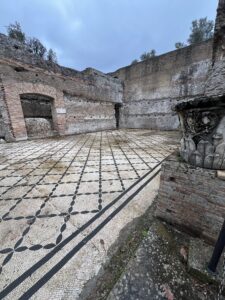Today, we got up and started our day in the classroom. We learned more about compression members with an emphasis on domes. Our class time was highlighted by a paper dome-building competition. We split into teams, and the group with the strongest team would win a gelato treat from Professor Besser. The champions of the day were Ethan, Gentry, Thomas, and Erik.
We continued our journey to Tivoli and Hadrian’s villa. Hadrian created his Villa to be more of a city surrounding his home. This was done out of his personal distaste for Palatine Hill. The Villa took many years to construct, and sadly, Hadrian was only able to live there for a few years. There were tons of amazing mosaic tiles laid on the floor and so many rooms to explore. There were lots of different areas that were specifically for the emperor and his family. Hadrian did not abandon the palace in Rome. However, they certainly liked the area outside for a quieter. One of the coolest sights on the trip was the Canopus and Serapeum. This is a large pool surrounded by many columns and statues, said to connect his villa with the ancient city of Alexandria. The villa is expensive with the grounds covering 250 acres (about the total floor space of the Pentagon).
Our next stop was still in the city of Tivoli where we checked out Villa d’Este. Before we began our tour, we found lunch within the city. The class found paninis, pizza, and gelato to refuel for the villa. During the tour, the class quickly learned why the villa is so famous. The Villa is terraced on a hillside with a stunning garden and an extraordinary system of fountains. The original owner, Cardinal Ippolito d’Este, ordered the construction of Villa d’Este in 1550. At one end of the garden is the Fontana dell’Organo. This is a fountain with an Organ built into it. The instrument is played by the water through a complex hydraulic system. The fountain was commissioned in the late 1500s by Cardinal Alessandro d’Este. The hydraulic systems contain water that naturally flows down the hillside, and it’s all used to supply the 51 fountains and nymphaeums, 398 spouts, and 364 water jets. This was one of the most visually stunning treats of the trip thus far.


No Comments